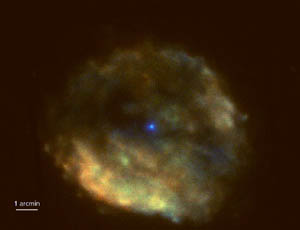It sounds like an alien world from the latest Dr Who plot, but new observations of an X-ray source within the 2,000-year old supernova remnant RCW 103 hint at the presence of a strange kind of magnetar, a neutron star with an ultra-high magnetic field. Or, do they? The observations could be interpreted in another way as an X-ray binary pair of a neutron star or a black hole and another low-mass star.
Whichever hypothesis represents the true script for this 2000-year old supernova, the finding may suggest that supernova explosions produce a wider range of formations than previously thought, Italian researchers say.

Andrea De Luca
Post-doctoral students Andrea De Luca and Andrea Tiengo working with Patrizia Caraveo and Sandro Mereghetti at INAF-IASF Milano in Milano, Italy, and Giovanni Bignami of the CESR, CNRS-UPS in Toulouse, France, and the University of Pavia, Italy, have carried out observations of the unusual periodicity of this cosmic X-ray source as well as its long-term flux variations. The observations made with the Newton X-ray Multimirror Mission (XMM) suggest that the source may be a magnetar that has been slowed down by a spinning disc of stellar debris left behind by the supernova explosion.
“This would be the first known example of such a braked magnetar,” de Luca told Spotlight, “the alternative scenario of a low-mass binary system would be very interesting, too and would be the first case of a low-mass X-ray binary caught in its infancy.” He adds that conventional, well-known low-mass X-ray binary systems are hundreds of millions of years old.

XMM picture of RCW103 (Credit: ESA, XMM-Newton, A. De Luca et al)
The researchers point out that there are lots of details missing from the picture of both 1E and RCW 103. They reckon that deeper and longer X-ray observations might reveal fast pulsations and so rule out the idea of the system being a slow rotator. Moreover, measurements made during the source “high state” could allow so-called phase-resolved spectroscopy to be recorded providing evidence for other material around the star obscuring our view. On the other hand, optical and infra-red observations could disclose the presence of a disc and spectroscopic studies of the diffuse remnant would also offer new clues about the nature of this supernova. The researchers add that, “Although difficult, such studies could be crucial in understanding a supernova event which, 2000 years ago, created either a compact object or a binary system unique in its physical properties.”
Further reading
Scienceexpress.org, 2006, July 6
http://dx.doi.org/10.1126/science.1129185
Patrizia Caraveo
http://www.iasf-milano.inaf.it/~pat/personal.html
Sandro Mereghetti
http://www.iasf-milano.inaf.it/~sandro/personal.html
Giovani Fabrizio Bignami
http://www.iasf-milano.inaf.it/~gfb/personal.html
Suggested searches
supernova
X-ray and astronomy